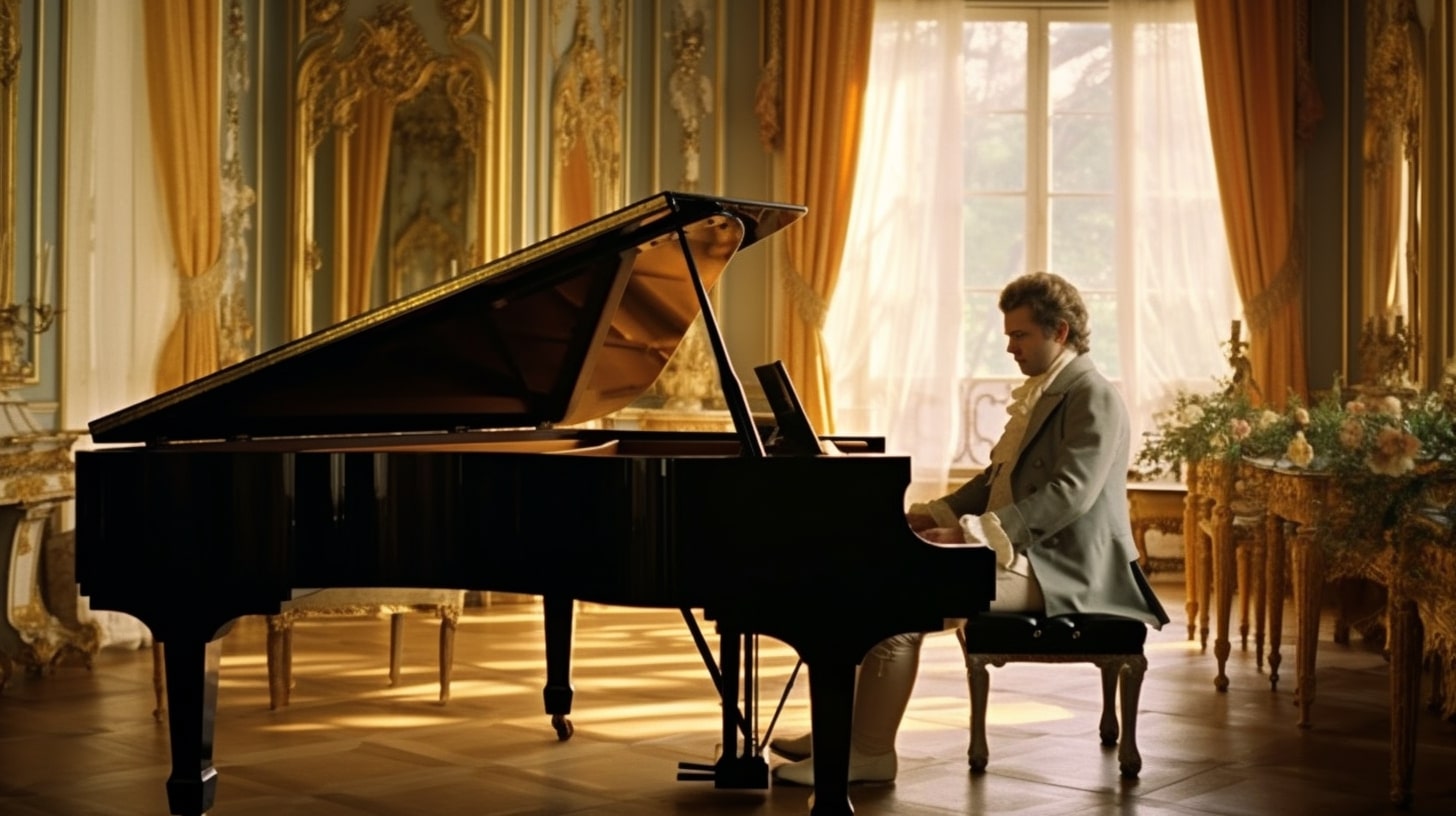Ludwig van Beethoven, a renowned German composer, and pianist, is widely admired for his contributions to the world of classical music. His extensive body of work has left an indelible mark on the transition from the Classical period to the Romantic era. One aspect of Beethoven’s genius that is often overlooked is his remarkable proficiency in playing multiple instruments.
Exploring Beethoven’s instrumental expertise provides a deeper understanding of the man behind the celebrated symphonies, sonatas, and concertos. His ability to traverse different instruments not only shaped his compositions but also served as a testament to his extraordinary talent within the world of music.
Contents
Ludwig Van Beethoven: Life and Career
Child Prodigy
Ludwig van Beethoven was born in Bonn, Germany, in 1770. He displayed musical talent from an early age, with his father, Johann, acting as his first piano teacher.
Johann was a strict and demanding teacher, often using harsh methods to teach Beethoven. Despite such a challenging upbringing, Beethoven continued to develop as a musician, mastering various instruments, including piano, violin, viola, and harpsichord.
Influential Composers and Mentors
As Beethoven’s talent began to emerge, he attracted the attention of several prominent musicians. One such mentor was Christian Gottlob Neefe, a German composer, and organist who took Beethoven under his wing and introduced him to the works of influential composers such as Bach and Mozart. Neefe recognized Beethoven’s potential and nurtured his development, even helping him publish his first compositions.
During his time in Bonn, Beethoven also worked with the court orchestra, where he met notable musicians such as the Kapellmeister and other ensemble members. These interactions furthered his musical education and allowed him to refine his skills as a performer and composer.
From Bonn to Vienna
In 1792, Beethoven moved to Vienna, the cultural center of Europe at the time. This move would prove to be a pivotal moment in his career, as Vienna provided him the opportunity to study with famed composers like Joseph Haydn, Antonio Salieri, and Albrechtsberger. These mentors played a crucial role in shaping Beethoven’s musical style and approach, laying the groundwork for his future success.
While in Vienna, Beethoven’s reputation as a pianist and composer grew, leading to numerous performance opportunities and commissions.
Soon, he established himself as one of the most important figures in Western music history, contributing significantly to the development of classical music. Despite facing numerous challenges, including his deteriorating hearing, Beethoven managed to produce a vast and diverse body of work that has left a lasting impact on future generations of musicians and composers.
Beethoven’s Main Instruments
Piano
Beethoven was a virtuoso pianist from a young age, and the piano was his primary instrument. He began taking lessons on the harpsichord, a precursor to the piano, evolving his skills as the piano gained prominence throughout his career. He mastered both instruments, allowing him to compose and perform intricate and expressive works.
Among pianos, Beethoven had a particular affinity for Érard pianos, famed for their robust construction and tonal clarity. His contributions to piano music include innovative sonatas, concertos, and variations.
Violin
While Beethoven is more commonly associated with keyboard instruments, he was also an accomplished violinist. He began learning the violin around the age of 7, studying under his father and later with notable violinists of the time.
Although he did not achieve the same level of fame as a violinist, the experience clearly influenced his compositional style, as seen in his splendid chamber music and symphonies that frequently showcased the strings.
Viola
As a versatile string player, Beethoven played the viola, the larger and deeper-toned sibling of the violin. While not as prominent in Beethoven’s performances or compositions as the piano and violin, the viola played an integral role in his string quartets, quintets, and symphonies.
Like with the violin, his expertise on the viola is evident in the rich harmonies and delicate counterpoint in his works for strings.
Organ
Lastly, Beethoven’s musical talent extended to the organ, another keyboard instrument. Though his training and performance on the organ were less frequent compared to the piano, the influence of the organ can be heard in his orchestral compositions.
The grand scale and harmonic complexity of his later symphonies bear witness to the impact of the organ’s powerful sonorities in his musical language.
Beethoven’s Compositions and Genres
Beethoven, a renowned German composer, and pianist, significantly impacted the world of classical music with his compositions. His works span various genres, including piano sonatas, string quartets, in addition to trios, symphonies, concertos, and opera.
Piano Sonatas
Beethoven’s piano sonatas play a crucial role in developing the classical sonata form. Some of his most famous piano sonatas include the Moonlight Sonata (Op. 27, No. 2) and Für Elise (WoO 59).
As a skilled pianist, Beethoven composed a total of 32 piano sonatas, notably beginning with his Opus 1, published in 1795. His sonatas are regarded as significant compositions that greatly influenced the evolution of piano techniques and the sonata form.
String Quartets and Trios
String quartets and trios form another important part of Beethoven’s works. He composed a total of 16 string quartets and 11 piano trios. The string quartets showcase Beethoven’s unique approach to classical music, particularly the Grosse Fuge (Op. 133), which exemplifies his bold experimentation with form, harmony, and counterpoint.
His piano trios also demonstrate his mastery of chamber music, featuring dialogues between the piano, violin, and cello parts in pieces like his Trio in B-flat major (Op. 97, “Archduke”).
Symphonies
Beethoven’s symphonies changed the course of Western classical music, and he composed a total of nine symphonies throughout his career. Among these, the Fifth Symphony (Op. 67) is arguably the most iconic, known for its memorable four-note motif that permeates the entire work.
Another notable work is the Ninth Symphony (Op. 125), which introduced choral forces into the symphonic genre and features the famous “Ode to Joy” theme. Beethoven’s symphonies encompass many emotions and often convey a sense of the heroic.
Concertos
As a composer and virtuoso pianist, Beethoven wrote several concertos, including five piano concertos and one violin concerto. His piano concertos showcased his talents at the keyboard and helped develop the genre. The Piano Concerto No. 4 (Op. 58) and Piano Concerto No. 5 (Op. 73, “Emperor”) are particularly celebrated works noted for their innovative and complex structures as well as their emotive character.
The violin concerto, Violin Concerto in D major (Op. 61), is the only one Beethoven composed. It remains one of the most highly-regarded pieces in the violin repertory, appreciated for its technical demands and profound emotional depth.
Opera
Beethoven ventured into the world of opera with his only work in this genre, Fidelio (Op. 72). Although not as widely performed as his other compositions, Fidelio is an important part of his oeuvre. The opera tells the story of a wife’s heroic efforts to save her unjustly imprisoned husband, reflecting Beethoven’s recurring themes of heroism, love, and freedom.
Influencing Pianoforte Development
Collaboration with Piano Makers
Beethoven played an important role in the development of pianos during his time. As a talented composer and pianist, he collaborated with various piano makers to enhance the instrument’s capabilities.
Some of the notable piano makers Beethoven worked with include Stein, Broadwood, Streicher, and Graf. Stein’s pianos were known for their innovative features, such as increased sound dynamics and improved keyboard action. Broadwood provided Beethoven with a more powerful instrument, which facilitated the composer’s transition to the Romantic era.
Streicher and Graf introduced modifications to the pianoforte and its internal mechanism, enabling greater expressiveness and versatility.
Impact on Piano Design
Beethoven’s interaction with these piano makers profoundly impacted the instrument’s design and evolution. Some of the major changes that emerged in response to Beethoven’s musical demands are:
- Sound: Beethoven sought a piano with a broader range of sound and power. To accommodate this, makers developed thicker strings, larger soundboards, and stronger frames. Consequently, the pianos during the Romantic period were more robust and provided greater resonance.
- Pedals: The composer’s music often required sustained notes or harmonies. To meet these needs, pianoforte manufacturers like Graf and Streicher introduced innovations such as the “una corda” pedal for quieter playing and the damper pedal to sustain sounds.
- Bridges: Beethoven’s music necessitated improved tuning stability. As a result, piano makers developed a new bridge design to maintain the instrument’s pitch, enabling more complex harmonies and structure.
- Action: To facilitate Beethoven’s intricate and dynamic musical ideas, the action of pianos needed refinement. Manufacturers like Stein pioneered innovations in the keyboard action providing finer control and enhanced responsiveness.
Given his close relationships with piano makers, Beethoven played a pivotal role in influencing the design and development of the pianoforte, shaping its trajectory from the Classical to the Romantic era. His creative genius, combined with the advances in piano construction, led to the birth of new forms of musical expression, thereby cementing his legacy in the history of music.
Beethoven’s Personal Struggles
Deafness
Beethoven’s most notable personal struggle was his deafness. His hearing began to deteriorate in his late twenties, and by the time he was in his forties, he was mostly deaf.
This was a significant obstacle for a musician and composer, but Beethoven continued to create music, despite his hearing loss. He relied on his knowledge of musical structure and harmony, as well as physical sensations, such as feeling the vibrations of the piano strings.
Alcoholism
Another struggle Beethoven faced was alcoholism. It is believed that Beethoven developed a drinking problem to cope with the emotional turmoil caused by his deafness. His alcohol consumption further exacerbated his health issues and has been linked to his eventual death. Beethoven’s relationship with alcohol not only affected his personal life but also impacted his work, as there are accounts of him being intoxicated during rehearsals and performances.
To sum up, Beethoven’s struggled with deafness and alcoholism. His hearing loss presented a significant challenge to his career as a composer, while his alcoholism affected his personal life and professional reputation. Despite these challenges, Beethoven is remembered as one of the greatest composers in history.
Beethoven’s Legacy
Impact on Romantic Era Music
Beethoven’s influence on the Romantic era of music cannot be overstated. His music marked a significant transition from the Classical period, characterized by composers like Mozart and Haydn, to the Romantic period. Beethoven’s innovative use of form, harmony, and emotional expression helped shape the development of Romanticism in music. His work inspired many composers who followed, including Schubert, Mendelssohn, and Brahms.
An essential aspect of Beethoven’s legacy is his bold and innovative compositions, like his use of the scherzo (a light, playful piece often used as a dance) in symphonies, which helped define the Romantic era’s approach to orchestral music.
His innovative approach to structure can be seen in his symphonies, pushing boundaries and expanding the depth of his compositions. Beethoven’s works provided a foundation for future composers to explore new ideas and express emotions more profoundly, further separating the Romantic era from its Classical roots.
Influence on Piano Composers and Performers
Beethoven was a virtuoso pianist, which is evident in his piano compositions. He revolutionized the piano sonata, taking it to new heights of emotional expression and technical complexity. As Johann van Beethoven’s student, Ludwig spent much time honing his piano skills, eventually coming under the tutelage of other prominent musicians such as Joseph Haydn and Antonio Salieri.
His innovative piano compositions, like the Pathétique sonata (Op. 13, published in 1799), provided the groundwork for many later piano composers and performers to push the instrument to its limits. His work expanded the range, capabilities, and expressive qualities of the piano. This influence can be seen in the works of composers like Franz Liszt, who, like Beethoven, was a virtuoso pianist and highly innovative composer.
Beethoven’s piano works, in both form and content, significantly impacted later composers such as Chopin, Schumann, and Rachmaninoff, who allowed a great debt to Beethoven’s style and approach to piano composition. Through his work, Beethoven helped to establish the piano as a critical instrument in both performance and composition, solidifying its place at the heart of the Romantic era.






